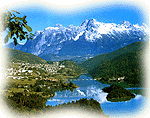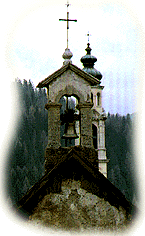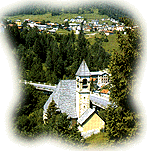 |


|
|
DOMEGGE DI CADORE |
|
| A Gallic helmet unearthed in nearby Vallesella and the Celtic tombs at the centre of town confirm the ancient origins of the settlement. The name Domegge is of Roman derivation - probably from duo milia, or "two miles", the distance between the village and the military presidio of Pieve - while the town's Patron Saint George suggests it was a Longobard settlement. Three dates are of crucial importance in the history of the town: AD 809, when the first public oratory was built; 1208, when the parish was declared autonomous, separate from the diocese of Pieve; and 1394, when its constitution was written. From the hands of Squire Scaffardo Domegge it was passed on to the Caminesi family, and later, as part of the whole Cadore district, it came under the dominion of the Venice Republic until 1797, taking part in the skirmishes incited by the League of Cambrai from 1508 to 1513. It is believed that in the Middle Ages in a place still called Ciastelloi, used to stand, a castle overlooking the area of the modern town. The most illustrious son of Domegge is perhaps Canon Giuseppe Ciani, known also as the "Cadore Herodotus" for his 19th-century monumental compilation tracing the history of the Cadore people. Today Domegge's economy is based mainly on the production of eyeglasses and accessories and on tourism. The town, with a population of 2,700 (including the villages of Vallesella and Grea), sprawls along the shores of Lake Cadore, from which extend like sun-rays up the wooded slopes numerous trails. Among the points of interest are the Valmassoni House, an elegant 16th-century brick and wood mansion at the centre of town; the impressive parish church of San Giorgio, built in 1861-65 based on a modified plan by Segusini, where a fine Marco Vecellio canvas hangs; the church of San Rocco, where a painting by another Vecellio, Francesco, is on view; the church of the Madonna del Molinà, an asymmetrical polygonal building which is also known as the "Armistice Church", as on November 4, 1918 the Italian army broke through the Piave front and arrived here. Further away, in the village of Grea, a charming alpine hamlet on a hill overlooking the valley, stands the small Gothic church of San Leonardo (built 1430). A road stretches from Domegge to the Padova Lodging in Val Talagona, point of departure for hikers climbing to Spalti di Toro. Near the lodging is an alpine garden for the study of mountain flora.
|
||



 APT
APT